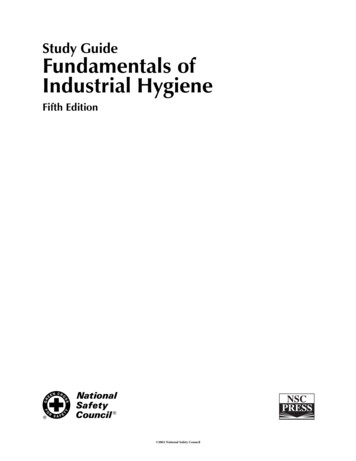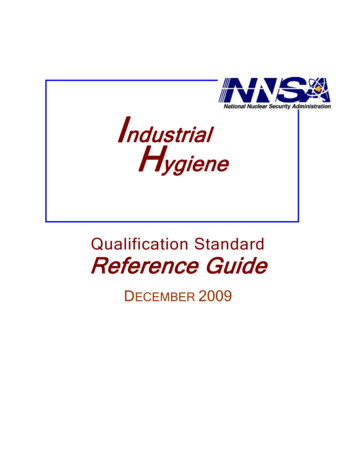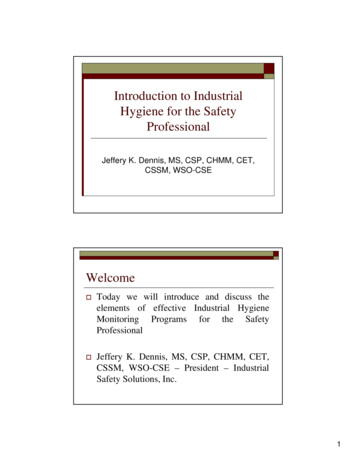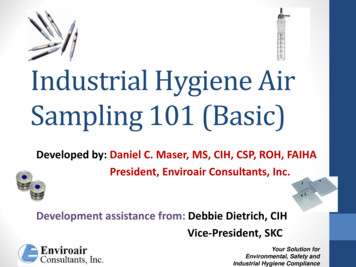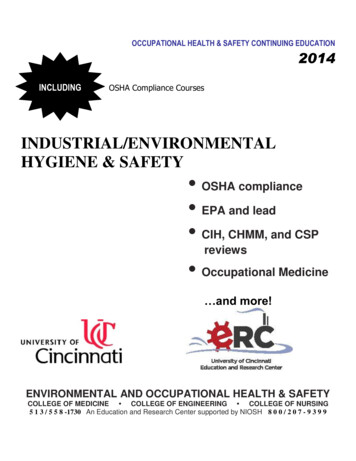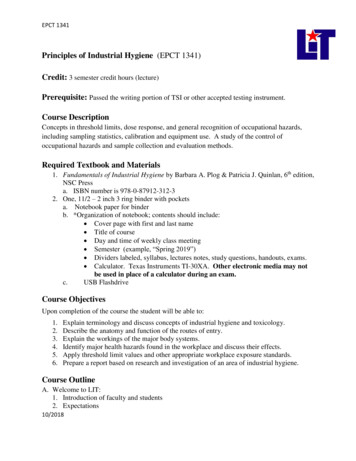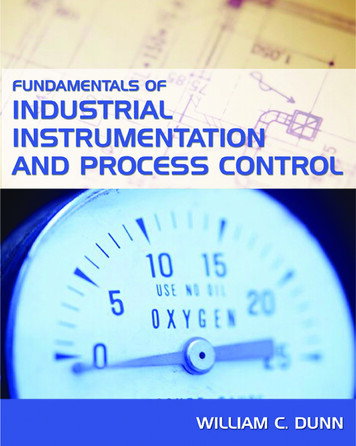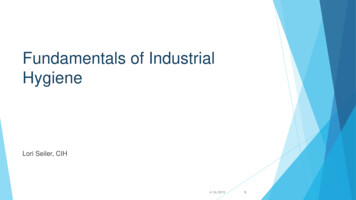
Transcription
Fundamentals of IndustrialHygieneLori Seiler, CIH4/16/20191
What is Industrial Hygiene?“ the science of anticipating, recognizing, evaluating, andcontrolling workplace conditions that may cause workers'injury or illness.Industrial hygienists use environmental monitoring andanalytical methods to detect the extent of worker exposureand employ engineering, work practice controls, and othermethods to control potential health hazards.”Source:4/16/20192
Typical Roles of an Industrial Hygienist Investigating and examining the workplace for hazards and potentialdangers Making recommendations on improving the safety of workers and thesurrounding community Conducting scientific research to provide data on possible harmfulconditions in the workplace Developing techniques to anticipate and control potentially dangeroussituations in the workplace and the community Training and educating the community about job-related risks Advising government officials and participating in the development ofregulations to ensure the health and safety of workers and their families Ensuring that workers are properly following health and safetyprocedures4/16/2019Source: www.aiha.org3
Industrial Hygiene lthHazardsRecognition4/16/20194
Industrial Hygiene Practice Technical CompetencySource: AIHAs Core Competencies for the Practices of IH, www.aiha.org4/16/20195
What Are Different Types ofIndustrial Hygiene Hazards?Let’s look at an example.4/16/20196
You have just been assigned a new facility to support . Before your first site visit, your local contact sends you the followingdescription:Our facility is a wood furniture manufacturer with approximately50 employees. The operation includes six primary process steps: Drying Machining Assembly Pre-finishing Coating applications Finishing4/16/2019Whathazardsdo youexpect?7
Example Industrial Hygiene Hazards Pre-finishing Heat, carbon monoxide, particulatesMachining Drying Noise, dust, Coating & Finishing Applications AssemblyNoise, adhesives, heat, solventsDust, resins, glues, acetone,ammonia, bleaching agentsMineral spirits, alcohols, solvents,pigments, lacquers, stains, paints,dustAny other examples?4/16/20198
General Industrial Hygiene Hazard TypesChemical HazardsPhysical HazardsBiological HazardsGasHeat StressBacteriaVaporCold StressFungiDustIonizing RadiationVirusesMistNon-Ionizing tsSmokeErgonomicsSolidLiquid4/16/20199
When evaluating chemical hazards,what information should you know?Physical formToxicity and Health HazardConcentrationHow the chemical is used4/16/201910
Types of Chemical Hazards Airborne Gas Vapor Dust Mist Fume Fiber Smoke Physical State Solid Gas Liquid VaporProperties & Appearance Vapor pressure Color Odor4/16/201911
Why is it important to know the physicalstate or form of a chemical in theworkplace?This helps determine the route of exposure4/16/201912
Routes of ExposureSource: /201913
Chemical Health Hazards Acute Toxicity Skin Corrosion or Irritation Eye Damage or Eye Irritation Respiratory or Skin Sensitization Mutagenicity Carcinogenicity Reproductive Toxicity Specific Target Organ Toxicity (e.g. Liver, Kidney, Nerves) Aspiration HazardSource: OSHA 3491 Hazard Communication Standard Pictogram Quick Card4/16/201914
Toxicity vs HazardWhat’s the difference?4/16/201915
Toxicity vs. HazardToxicity – ability to cause harmHazard – probability that toxic effect will occurRisk Hazard x Exposure4/16/201916
Evaluating ExposuresExposure Profile98Concentration (ppm)76543210012345678Time (Hours)4/16/201917
Evaluating Exposures, cont .Exposure Profile98Concentration (ppm)765438-hr TWA210012345678Time (Hours)TWA Time Weighted Average4/16/201918
Calculating an 8-hr TWA(C1 x T1) (C2 x T2) (C3 x T3) . (Cn x Tn)TtCn measured concentrationTn length of time sampledTt Total length of shift (e.g. 8-hrs)4/16/201919
TWA Problem cont Air sampling results for a worker’s exposure to gasoline found that he wasexposed the following: 108 ppm for 2 hours 50 ppm for 3 hours 200 ppm for 3 hours(108 ppm x 2 hrs) (50 ppm x 3 hrs) (200 ppm x 3 hrs)8 hrs8-hr TWA 121 ppm4/16/201920
What about these peak levels?98Concentration (ppm)78-hr TWA6543210012345678Time (Hours)TWA Time Weighted Average4/16/201921
Evaluating Exposures, cont .Exposure Profile9Concentration (ppm)8Exposure Limit7654328-hr TWA10012345678TWA Time Weighted Average4/16/201922
Exposure Limits“Airborne concentrations of a substance under which itis believed nearly all workers my be repeatedlyexposed, day after day, without experiencing adversehealth effects.”Does this present any complications? Some workers can experience discomfort at or below the levels Some workers can be more seriously affected because of a pre-existing condition4/16/201923
Exposure Limit Setting GroupsOccupational Safety &Health AdministrationPEL Permissible Exposure LimitAmerican Conference ofGovernmental IndustrialHygienistsTLV Threshold Limit ValueAmerican IndustrialHygiene AssociationWEEL Workplace EnvironmentalExposure LimitNational Institute ofOccupational Safety &HealthREL Recommended Exposure Limit4/16/201924Are thereothers?
Types of Exposure Limits 8-hour Time Weighted Average (TWA) Short-term Exposure Limit (STEL) Ceiling Limit (C) Excursion Limit Biological Monitoring Levels4/16/201925
Exposure Limit Durations 8-hour Time Weighted Average (TWA) Set for a routine 8-hr workday and a 40-hr work week Level is set so that nearly all workers may be repeatedly exposed withoutadverse health effects4/16/201926
Exposure Limit Durations cont Short-Term Exposure Limit (STEL) 15-min TWA, 60 minutes between peaks, maximum 4 times per day Set to prevent irritation, chronic, or irreversible tissue damage, narcosis Set for chemicals where there are acute toxic effects in addition to chroniceffects STEL is in addition to 8-hr TWA4/16/201927
Types of Exposure Limits 8-hour Time Weighted Average (TWA) Short-term Exposure Limit (STEL) Ceiling Limit (C) Concentration that should not be exceeded during any part of the workdayFor some substances, more that one type of limit may be relevant.4/16/201928
What If?You are evaluating chemical exposures during ashort-term task but there is no published STELor Ceiling limit for the chemical being used.What can you do?Consider an excursion limit.4/16/201929
Excursion Limits How to Apply Short-term exposures where there is no STEL or Ceiling Limit available Up to 3 times the 8-hour TLV-TWA for no more than a total of 30 minutesduring a workday Not to exceed up to 5 times the 8 hr-TLV-TWAApply in addition to the 8-hour TLV-TWA cannot be exceeded4/16/201930
Exposure Limit Units Expressed as concentrations Mass per unit volume of air Volume of material per volume of airExposure limits are listed by several different types of units mg/m3 milligrams per cubit meter of air ppm parts per million f/cc fibers per cubic centimeter of air4/16/201931
Biological Monitoring Limits Represent warning levels of biological response to either the chemicalor a metabolite Levels are measured in tissues, fluids, or exhaled airBlood lead levels – 40 µg/100 g4/16/201932
Exposure Limits, so far we’ve discussed Exposure limit setting groups Different types of limits 8-hr TWA STEL Ceiling Excursion BiologicalConcentration units and how to use themThere isone morething!Skin Notation4/16/201933
Skin Notation Refers only to the potential contribution to the overall exposure throughthe skin, mucous membranes, and eyes Exposure can be either airborne or through direct contact with substanceDesigned to raise awareness that skin exposures need to be prevented4/16/201934
Exposure Limit ExamplesGasolineOSHAACGIH TLVPEL-TWATLV-TWA300 ppmPEL- STELTLV-STEL500 ppmPEL-CTLV-CSkin NotationNSkin NotationNAcrylic AcidOSHAACGIH TLVPEL-TWA1 ppmTLV-TWA0.5 ppmPEL- STEL5 ppmTLV-STEL2.5 ppmPEL-CSkin NotationTLV-CNSkin NotationY4/16/201935
Industrial Hygiene lthHazardsRecognition4/16/201936
Hierarchy of ControlsSource: .html4/16/201937
Case Study ExerciseA maintenance crew has been assigned a job that involves refurbishing an old, out ofservice, 120 ft. diameter chemical storage tank.The tank previously contained leaded gasoline in the 1990’s. It now needs to becleaned out, inspected, and repaired so that it go back into service.Their job is to cut open the tank, clean out any residual material, and prepare the tankfor inspection. The inspection results will determine the type of repair work needed.The tank contents were pumped off by the tank farm operators. The crew plans toburn off the paint and then use a torch to cut out a large door opening.During the job, several of the workers report symptoms of fatigue, headache, andmuscle soreness. One reports having a “metallic taste” in his mouth.The workers go to the medical department and two are found to have a dark line ontheir gums.4/16/201938 Hazards present? Exposure concerns? Control strategies?
Industrial Hygiene FunctionsAnticipationControlProcess knowledgeExperienceContinuing educationEliminate/Reduce HazardsEngineering ControlsAdministrative ControlsPersonal Protective onSamplingObservationsInterviewsInspections, audits4/16/201939
Fundamentals of Industrial Hygiene Know types of hazards to expect Understand toxicology and how chemicals affect the body Recognize routes of exposure Evaluate/measure exposure levels Compare exposure levels to appropriate exposure limit Devise control strategies to eliminate/reduce worker exposuresBottom Line: Keep workers, their families and thecommunity healthy and safe4/16/201940
Fundamentals of Industrial Hygiene Know types of hazards to expect Understand toxicology and how chemicals affect the body Recognize routes of exposure Evaluate/measure exposure levels Compare exposure levels to appropriate exposure limit Devise control str
